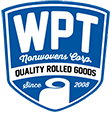Manufacturers who wish to use nonwoven fabrics for their products have a wide range of fiber options. For some applications, natural fibers like cotton are a good choice, but for others, a synthetic fiber such as polyester, might provide better attributes. When selecting fibers, it is important to consider the characteristics of a given fiber in light of the characteristics you want your final product to have.

Strength of a Nonwoven Fiber
When your product needs to be strong and durable, synthetic fibers offer high tensile strength. High strength synthetic fibers can be blended with weaker fibers to create a rugged bicomponent fiber nonwoven. Polyester filament or a polyester blend fiber provide excellent strength since polyester nonwovens are high density.
Temperature Resistance of a Nonwoven Fiber
When your nonwoven product needs to have resistance to temperature, good fibers to choose include: cotton, rayon, polyester, and blends. Chemical bonding is also an effective way to develop temperature resistant nonwovens. The process of chemical bonding involves the application of a chemical binder to join polyester and rayon fibers to create beneficial characteristics to nonwovens, including temperature resistance.
Resistance to Shrinking or Stretching
For nonwovens that need to retain their shape, without shrinking, stretching, or creasing, polyester fibers are an excellent choice. Chemical bonding and bicomponent fibers can also be useful in creating characteristics such as resistance to washing or dry cleaning, resistance to aging, as well as superior flexibility and handling.
Absorbency of a Nonwoven Fiber
For excellent absorption and release, with a high degree of comfort and softness, cotton fiber is a great choice. Natural fibers, rayon filament and rayon blend are derived from wood pulp, and offer high absorbency, softness, and comfortable finish. Nonwoven cotton and nonwoven rayon are great choices for hygienic products such as feminine items, diapers, and personal wipes. When durability is important – for products like cleaning wipes – other types of fibers can be treated or blended to create a hydrophilic nonwoven.
Sustainability of a Nonwoven Fiber
If sustainability is a priority to you as a manufacturer, natural fibers are a responsible choice. While natural fibers are assumed to be more expensive, they can be made in a way that makes them very cost competitive with synthetic fiber products. Choosing a supplier that is experienced in developing environmentally friendly nonwovens is important. Regulations concerning the environment have led many manufacturers in a variety of industries to switch from synthetic fiber nonwovens to compostable or biodegradable fiber environmentally friendly and sustainable nonwovens.
No matter the industry or the application, WPT Nonwovens has the experience, equipment, and development capabilities to create the right nonwoven for the job. Call us to discuss your project.

